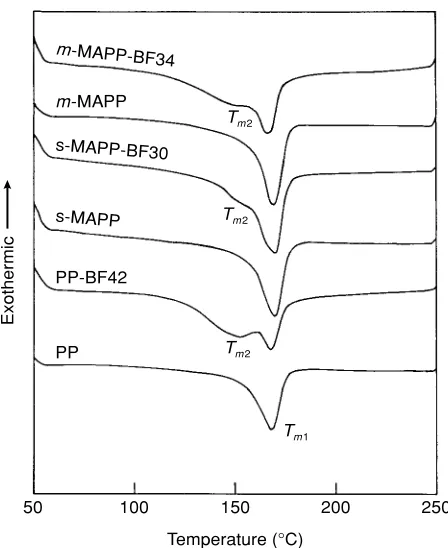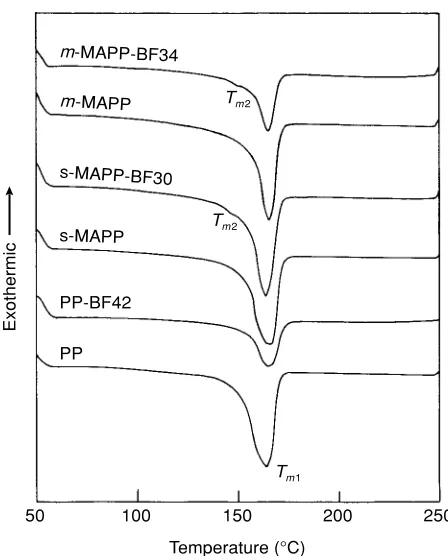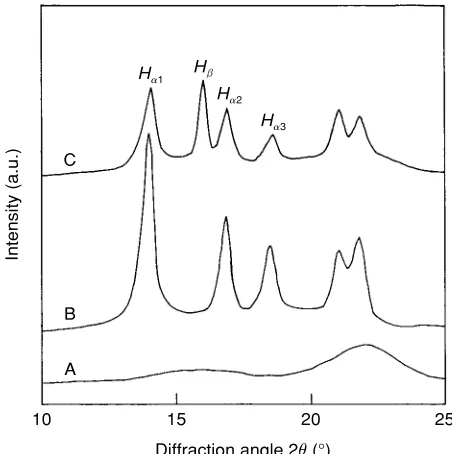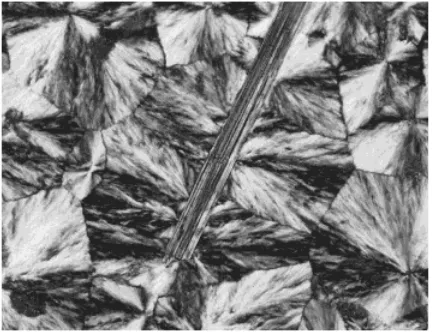Crystallization and Interfacial Morphology
YONGLI MI,1
XIAOYA CHEN,1
QIPENG GUO2 1
Department of Chemical Engineering, The Hong Kong University of Science and Technology, Clear Water Bay, Kowloon, Hong Kong
2Department of Materials Science and Engineering, University of Science and Technology of China, Hefei 230026, China
Received 19 February 1996; accepted 1 June 1996
ABSTRACT: Bamboo fiber-reinforced polypropylene ( PP ) composites were prepared. PP and two maleated polypropylenes ( s-MAPP andm-MAPP ) were used as matrices. Crys-tallization and interfacial morphology were studied by using differential scanning calo-rimetry ( DSC ) , wide angle X-ray diffraction ( WAXD ) , and optical microscopy. It has been shown that the addition of bamboo fiber to any of the three polymers causes an increase in the overall crystallization rate. A considerable amount ofb-form crystallin-ity was produced in the PP, s-MAPP, andm-MAPP by mixing with bamboo fiber ; and all the bamboo fiber-filled samples contain both thea- and theb-forms. The relative amount of theb-form in the samples was calculated from WAXD data by theKvalue. There is nob-form observed in the pure PP, s-MAPP, andm-MAPP. Bamboo fiber acted as both a reinforcement and ab-nucleator. The nucleation density of both s-MAPP and m-MAPP at the fiber surface is remarkably higher than that of PP because an improved interfacial adhesion is reached in the case of s-MAPP andm-MAPP as matrices. The transcrystalline growth of s-MAPP and m-MAPP on the bamboo fiber surface was observed under optical microscope with crossed polars.q1997 John Wiley & Sons, Inc. J Appl Polym Sci64:1267 – 1273, 1997
INTRODUCTION
stitutes in the form of wood fiberboard are avail-able, these products are generally of mediocre mechanical performance and cannot meet the standards required for wide application in con-Wood is a basic material sustaining human living.struction and industrial processes.1,2
Thus, there It is widely used in interior decoration and in the
is an increasingly urgent need for developing high furniture industries. The insatiable world
de-quality timber substitute products that can bene-mand for good quality timber has led to
nonrenew-fit the global industrial and business develop-able logging of tropical hardwood forests in many
ment, with due regard for the world environment. developing countries and gave rise to serious
Recently, many works have started with bamboo global concern. As rain forest supplies shrink
fibers as naturally organic fillers of polymer com-while development accelerates, it is expected to
posites. The reason that many studies focus on lead to a sharp rise in the cost of natural timber
bamboo is because bamboo is an abundant natu-products in the near future. Although timber
sub-ral resource in Asia, and its ovesub-rall mechanical
properties are comparable to those of wood.3
Fur-Contract grant sponsor: R.G.C., the Earmarked Grant for
thermore, bamboo can be renewed much more Research
rapidly compared with wood. The time required Contract grant number: 581 / 94E
eight months, less than 5% of that for wood. It tor according to the method as described in
Mar-tiner et al.8
and Sathe et al.9
The content of MAH has been shown that bamboo-reinforced
compos-ites have desirable mechanical properties.4 – 7
grafted onto the PP was ca. 1%. The sample thus obtained was designated as s-MAPP. The second However, the polymer matrices currently
encoun-tered in this field are epoxy and polyester in their type of maleated PP was prepared by directly
re-active-mixing PP with MAH and a peroxide initia-solid form, which are both expensive and brittle.
In order to obtain an economical substitute tor according to the method as described in Lin.10
The reaction of MAH with PP was conducted by having properties similar to those of wood, a
proj-ect is conducted in this laboratory to develop a loading PP powders into the mixing chamber of a
Haake Plasticorder at 1607C while maintaining
new type of composite materials — thermoplastic
bamboo fiber-reinforced polypropylene ( PP ) com- the speed of the screws at 30 rpm. After 3 min,
the PP was molten, and dicumyl peroxide ( DCP ) posites. PP was chosen as matrix resin due to its
low price and favorable mechanical properties. was added for another 4 min. Finally, MAH was
added for a further 3 min mixing. The content of The goal of this research program is to make the
composites in the form of boards, rods, and thin MAH was 1 phr. The sample thus obtained was
designated asm-MAPP.
sheets. Bamboo fiber-reinforced PP composites
are expected to have the following properties: Bamboo materials used belonged to the species
Bambusa paravariabilis, which is grown abun-lightweight, good weathering ability, good
de-sign and manufacture flexibility, and medium dantly in Asia. Bamboo clumps were chopped into
small chips with a roller machine. Bamboo fiber strength, which are to be used in furniture and
construction industries. In this article, we present was prepared by breaking the bamboo materials
in a Toshiba MX-301 high-speed laboratory here some preliminary results of our study on the
bamboo fiber-reinforced PP composites. In order blender. The bamboo fiber thus obtained was then
dried at 807C in a vacuum oven for 48 h and was
to promote the interaction between matrix and
bamboo fiber, maleated polypropylenes ( s-MAPP separated with a 500mm sieve.
The composites were prepared by using a andm-MAPP ) were also used. Particularly,
crys-tallization and interfacial morphology were stud- Haake Plasticorder. The polymer and the bamboo
fiber were directly added into the mixing cham-ied by using differential scanning calorimetry
( DSC ) , wide angle X-ray diffraction ( WAXD ) , ber, and the composite samples were prepared at
1807C and were further pressed at 1807C into
and optical microscopy. This investigation will
en-able us to understand better the structure – prop- sheets of various thickness. The pure polymers,
PP, s-MAPP, and m-MAPP, were subject to the
erties relationship of the composite materials and
the complicated problem of interface adhesion be- same treatment and were also pressed into
sheets. tween natural organic fillers and synthetic
poly-mers.
Measurements
A TA 2100 differential scanning calorimeter was
EXPERIMENTAL
employed to obtain the melting behavior of the samples. The sample weight used in the DSC cell
Materials and Preparation of Composites
was kept in the 8 to 12 mg range. The samples
were first heated to 2507C and maintained at that
The matrix materials for the preparation of the
composites included PP and two types of maleated temperature for 5 minutes. They were then cooled
to 507C at a rate of 107C /min to trace the
crystalli-PP. The sample of PP, Profax 6201, was supplied
by Himont Chemical Inc. It has an MFRÅ20 and zation process, followed by heating to 2507C again
to observe the melting behavior. A heating rate of
a density of 0.920 g / cm3
.
In order to promote the interaction between PP 107C /min was used in all cases. The heat of fusion
was calculated from the melting peak area, and and bamboo fiber, a reactive agent maleic
anhy-dride ( MAH ) was used. The reaction can be car- the maximum of the endotherm and the minimum
of the exotherm were taken as the melting tem-ried out either in solvent as a reaction medium or
directly in a batch mixer. The first type of male- perature (Tm) and the crystallization
tempera-ture (Tc) , respectively. ated PP used was prepared by solution surface
RESULTS AND DISCUSSION
Crystallization and Melting Behavior
Figure 1 shows DSC scanning curves of
as-pre-pared samples at a heating rate of 107C /min for
PP,m-MAPP, s-MAPP, and the composites. Table I lists the melting temperatures and endothermic heats of pure polymers and the composites. For the pure PP, only a single endothermic peak
oc-curs atTm1Å1697C, corresponding to the melting
of itsa-crystalline phase. It can also be seen that
both the purem-MAPP and the s-MAPP exhibit a
single melting endothermic peak atTm1Å1697C,
referred to the melting of thea-crystalline phase
of their PP sequences. However, a new
endother-mic peak Tm2 appears at lower temperature for
all the composites. The values for Tm2 are 152,
150, and 1507C, corresponding to the melting of
the b-crystalline forms of the PP, s-MAPP, and
m-MAPP in the composites, respectively. Jacoby
et al.11
and Varga12
have measured the melting temperatures of all crystalline forms of PP. For
Exothermic
Figure 1 DSC scanning thermograms of as-prepared
for the b-form was 1527C. It is clear that the b
-samples of the plain polymers and their composites.
phase structure was formed in all the three kinds The heating rate is 107C /min.
of bamboo fiber-filled composites. The same phe-nomenon has been observed and studied in detail in our previous work on the PP composites filled
PW 1830 diffractometer with Cu-Karadiation
op-erating at 40 KV and 50 mA at room temperature. with wollastonite13
and with rare earth oxides.14
Figure 2 shows the DSC traces of PP, s-MAPP,
The angular scale and recorder reading ( 2u) were
calibrated to an accuracy of 0.01 degrees. Samples m-MAPP, and their composites at a cooling rate
of 107C /min. The related cooling crystallization
were of uniform thickness and approximately 1.5
mm thick. data are listed in Table II. For the pure polymers,
PP, s-MAPP, and m-MAPP, an exothermic peak
Composite films containing single bamboo fiber
were prepared for optical examination. An Olym- occurs at TcÅ107, 109, and 1167C, respectively.
For their composites, these exothermic peaks shift pus BH2-MJLT optical microscope equipped with
cross-polarizers was used. respectively to high temperatures at Tc Å 110,
Table I Melting Behavior andb-Form Content of the As-prepared Samples of PP, s-MAPP,m-MAPP,
and the Composites
DHf1,2 Polymer/Filler
Sample (w/w) Tm2/Tm1(7C) (J/g Compos.) (J/g Polym.) KValue
PP 100/0 — /169 107.1 107.1 0
PP-BF42 58/42 152/168 66.5 114.7 0.35
s-MAPP 100/0 — /169 99.2 99.2 0
s-MAPP-BF30 70/30 150/169 72.5 103.5 0.23
m-MAPP 100/0 — /169 111.6 111.6 0
Exothermic
50 100 150
Temperature (ƒC)
200 250 PP
PP-BF42 s-MAPP s-MAPP-BF30 m-MAPP m-MAPP-BF34
Figure 2 Cooling crystallization thermograms at
Exothermic
50 100 150
Temperature (ƒC)
200 250 PP
PP-BF42 s-MAPP s-MAPP-BF30 m-MAPP m-MAPP-BF34
Tm2
Tm1
Tm2
0107C /min for the plain polymers and their composites.
Figure 3 DSC scanning thermograms after the cool-ing crystallization for the plain polymers and their com-posites. The heating rate is 107C /min.
114, and 1177C. The higher Tc values of the
com-posites than those of the pure polymers indicates
that the crystallization rate of the composites be- temperatures and endothermic heats of the
poly-mers and the composites. It can be seen that all comes more rapid. The increase in Tc can be
con-sidered to be due to the nucleation effect of the the three pure polymers exhibit a single melting
endothermic peak at Tm1 Å 1667C, attributed to
bamboo fiber. Certainly, it appears that bamboo
fiber can act as a nucleating agent for PP, s- the melting of thea-crystalline form. It is noted
that the PP / bamboo fiber composite PP-BF42 also
MAPP, andm-MAPP in the composites.
The melting behavior after the cooling from the has a single melting endothermic peak at Tml
Å 1657C due to the melting of its a-crystalline
melt for PP, s-MAPP,m-MAPP, and their
compos-ites at a heating rate of 107C /min is presented form, implying that there is nob-crystalline phase
formed during the cooling process. However, it can in Figure 3. Table III summarizes the melting
Table II Cooling Crystallization Data of PP, s-MAPP,m-MAPP,
and the Composites
DHc Polymer/Filler Tc
Sample (w/w) (7C) (J/g Compos.) (J/g Polym.)
PP 100/0 107 100.4 100.4
PP-BF42 58/42 110 43.4 74.8
s-MAPP 100/0 109 99.0 99.0
s-MAPP-BF30 70/30 114 78.4 112.0
m-MAPP 100/0 116 103.4 103.4
Table III Melting Behavior after Cooling Crystallization of PP, s-MAPP,
m-MAPP, and the Composites
DHf1,2 Polymer/Filler
Sample (w/w) Tm2/Tm1(7C) (J/g Compos.) (J/g Polym.)
PP 100/0 — /166 103.9 103.9
PP-BF42 58/42 — /165 46.1 79.5
s-MAPP 100/0 — /166 101.6 101.6
s-MAPP-BF30 70/30 148/163 85.7 122.4
m-MAPP 100/0 — /166 103.7 103.7
m-MAPP-BF34 66/34 150/166 46.3 70.2
be seen from Figure 3 that there is only a small where Ha1, Ha2, and Ha3 are the heights of the
three strong equatorial a-form peaks ( 110 ) ,
endothermic peak that occurred atTm2Å148 and
1507C, respectively, for the s-MAPP andm-MAPP ( 040 ) , and ( 130 ) ; and Hb is the height of the
strong singleb-form peak ( 300 ) . TheKvalues for
composites, referred to as the melting of theirb
-crystalline forms. This result suggests that the all the three bamboo fiber-filled composites were
calculated from their WAXD patterns by using eq.
content of theb-crystalline phase formed in these
two bamboo fiber-filled composites during the ( 1 ) . Table I lists theKvalues thus obtained. It is
interesting to notice that theKvalue reached as
cooling process is rather low.
The DSC results presented here clearly show high as 0.95 for the PP samples prepared by using
b-nucleators, as reported by Shi et al.16
In the
that a considerable amount of theb-phase form
existed in the as-prepared bamboo fiber-filled present case, theKvalues for these bamboo
fiber-filled composites are only moderate. This can be
composites. Liu et al.13,14
have found that some
inorganic fillers might act as b-nucleators and due to the larger size of bamboo fiber and then
the relatively smaller specific surface area since
formed larger amounts of theb-form; hence, the
properties of the related composites should be remarkably influenced. The present work fur-ther shows that bamboo fiber can also act as a
b-nucleator.
X-Ray Diffraction
The WAXD measurement shows that PP,
s-MAPP, m-MAPP, and their composites exhibit
three strong equatoriala-form peaks of PP or PP
sequences, ( 110 ) , ( 040 ) , and ( 130 ) . The WAXD patterns of the pure PP and the PP-BF42 compos-ite are shown in Figure 4. The pattern of the
com-posite gives a new peak located at 2uÅ16 degrees,
which is the characteristic single b-form peak
( 300 ) . Figure 4 also presents the WAXD pattern of a bamboo chop. No diffraction peak is located
between 2uÅ10 and 20 degrees for the bamboo
material. The relative amount of the b-form is
usually described in terms of theKvalue, which 10
A
Diffraction angle 2u (ƒ)
Intensity (a.u.)
20 25
is defined as follows:15
Figure 5 Optical micrographs with crossed polars of Figure 6 Optical micrographs with crossed polars of bamboo fiber in s-MAPP matrix, showing transcrystal-bamboo fiber in PP matrix (1100 ) .
line growth on the bamboo fiber surface (1100 ) .
only the surface of the bamboo fiber can induce Figures 6 and 7 clearly show transcrystalline
the formation of theb-form. growth of s-MAPP andm-MAPP on the bamboo
fiber surface, respectively. The appearance of transcrystalline growth displays that the
nucle-ation density of both s-MAPP and m-MAPP on
Interfacial Morphology
the bamboo fiber surface is sufficiently high. The embryonic spherulites begin to impinge greatly It has been well known that the mechanical
prop-erties of fiber-reinforced materials depend criti- on each other so that normal three-dimensional
growth is impossible; consequently, the spheru-cally upon the fiber-matrix interfacial adhesion.
However, the situation is rather confused as far lites grow predominantly in one direction, normal
to the surface. It can also be seen from the Figures as the properties of the interface are concerned.
When using crystallizable thermoplastics, e.g., 6 and 7 that the spherulites of both s-MAPP and
m-MAPP occur throughout the remaining matri-PP, as matrix, there exists a direct effect of the
fibers on the processes of the crystallization; ces; and the spherulites of s-MAPP andm-MAPP
in the composites are somewhat smaller than hence, it becomes possible to develop molecular
orientation in the matrix. As a result, the interfa-cial adhesion may be additionally influenced by the morphology of the matrix close to the filler surface. For PP, heterogeneous nucleation can oc-cur readily in the presence of certain fiber as
re-cently reviewed by Folkes.17Figure 5 is an optical
micrograph with crossed polars of bamboo fiber in PP matrix. It can be clearly seen that there exists nucleation phenomena on the bamboo fiber sur-face and isolated spherulites start to grow at sev-eral points along the bamboo fiber. However, nor-mal three-dimensional growth is hindered, and the growth direction of the spherulites is limited. It should be pointed out that the nucleation den-sity at the fiber surface is not sufficiently high since there is not yet transcrystalline growth
around the fiber. It is noted that the spherulites Figure 7 Optical micrographs with crossed polars of
of PP occur throughout the remaining matrix and bamboo fiber in m-MAPP matrix, showing
2. S. Kakase and N. Shiraishi, J. Appl. Polym. Sci., those in the PP composite and display irregular
37,645 – 659 ( 1989 ) . shape.
3. S. C. Lakkad and J. M. Patel,Fibre Sci. Technol., It clearly appears that bamboo fiber exhibits a
14,319 ( 1980 ) .
stronger nucleation effect to s-MAPP andm-MAPP
4. F. G. Shin, X. J. Xian, and M. W. Yipp,Proc. ICCM-than to PP. The nucleation density of both s-MAPP
VII,3,469 ( 1989 ) . and m-MAPP at the fiber surface is remarkably
5. X. J. Xian and F. G. Shin, Adv. Mech., 19, 515 higher than that of PP. This is because an
im-( 1989 ) . proved interfacial adhesion between the filler and
6. U. C. Jindal,J. Compos. Mat. Lett.,20,19 ( 1986 ) . the matrix is reached in the case of s-MAPP and
7. Seema Jain, U. C. Jindal, and R. Kumar,J. Mater. m-MAPP as matrices. The development of
trans-Sci. Lett.,12,558 ( 1993 ) . crystallinity around the bamboo fiber further
en-8. J. M. G. Martiner, J. Taranco, O. Laguna, and E. P.
hance the interfacial strength.17
Nonpolar polymer
Collar,Inter. Polym. Proc. IX,3,246 ( 1994 ) . PP is fairly inert, whereas the surface of bamboo
9. S. N. Sathe, G. S. S. Rao, and S. Devi, J. Appl. fiber is rendered hydrophilic, owing to the surface
Polym. Sci.,53,239 ( 1994 ) .
hydroxyl groups.3
The interfacial adhesion
be-10. C. W. Lin,J. Mater. Sci. Lett.,12,612 – 614 ( 1993 ) . tween bamboo fiber and plain PP matrix is very
11. P. Jacoby, B. H. Bersted, W. J. Kissel, and C. E. weak. Thus, modification of PP by grafting MAH
Smith, J. Polym. Sci., Polym. Phys. Ed., 24, 461 has been adopted to improve the interfacial
adhe-( 1986 ) . sion between the bamboo fiber and the matrix. This
12. J. Varga, inPolypropylene: Structure, Blends and results in an improved interfacial adhesion in the
Composites, Vol. 1, J. Karger-Kocsis, Ed.,
Chap-case of s-MAPP and m-MAPP and will further man & Hall, London, 1995, Chap. 3.
greatly enhance the strength of the composites, as 13. J. Liu, X. Wei, and Q. Guo, J. Appl. Polym. Sci.,
will be discussed elsewhere.18
41,2829 ( 1990 ) .
14. J. Liu, G. B. Tang, G. J. Qu, H. R. Zhou, and Q. The authors thank Dr. F. G. Shin of Hong Kong
Poly-Guo, J. Appl. Polym. Sci.,47,2111 ( 1993 ) . technic University for his kind help in preparing
bam-16. G. Shi, Y. Cao, B. Huang, and S. Huang, Acta boo fibers.
Polym. Sinica,5,359 ( 1987 ) .
17. M. J. Folkes,Polypropylene: Structure, Blends and Composites, Vol. 3, J. Karger-Kocsis Ed.,
Chap-REFERENCES
man & Hall, London, 1995, Chap. 10.
18. X. Chen, Y. Mi, C. M. Chan, and Q. Guo, to be 1. M. M. Sain and B. V. Kokta, J. Adhes. Sci.



